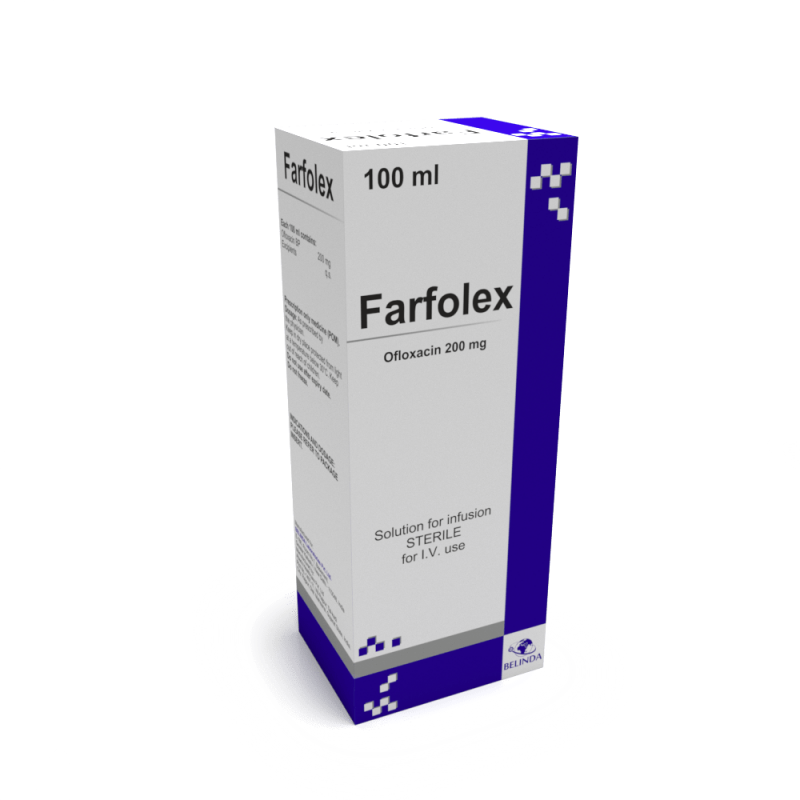
Farfolex
PRESCRIPTION
Ofloxacin is a quinolone-carboxylic acid derivative with a wide range of antibacterial activity against both Gram-negative and Gram-positive organisms. It inhibits bacterial DNA replication by blocking DNA topo-isomerases, in particular DNA gyrase. Antimicrobial spectrum includes Gram-positive aerobes: Staphylococcus aureus (meticillin-susceptible), Staphylococcus epidermidis (meticillin-susceptible), Staphylococcussaprophyticus, Streptococcus pneumoniae (penicillinsusceptible), Streptococcus pyogenes.
Manual
After a single infusion of 200 mg ofloxacin in 60 minutes Cmax is 2.7 mcg / ml, the concentrations at 12 hours after dosing is 0.3 mcg/mL. Steady-state concentrations were attained after four doses, and the area under the curve (AUC) was approximately 40% higher than the AUC after a single dose. The mean peak and trough plasma steady-state levels attained following intravenous administration of 200 mg of ofloxacin q 12 h for seven days were 2.9 and 0.5 μg/mL, respectively.
It is indicated for the treatment of the following infections, when caused by sensitive organisms:
- Respiratory tract infections (acute and chronic bronchitis, pneumonia, including those caused by intracellular or atypical pathogens, with the exception of pneumococcal infections);
- Acute, chronic and recurrent infections of upper respiratory tract (except for cases of acute tonsillitis – strains as Streptococcus spp. moderately susceptible to ofloxacin, the drug should not be used as a tool of choice for the treatment of pneumonia caused by pneumococcus, and acute tonsillitis (ß-hemolytic streptococcus));
- Infections of skin and soft tissue;
- Infection of bone (osteitis, osteomyelitis) and joints;
- Abdominal infections, including infections of the biliary tract;
- Intestinal infections, including escherichiosis, salmonellosis, shigellosis, cholera, yersiniosis;
- Infectious and inflammatory diseases of the pelvic organs (pelvioperitonit, salpingitis, oophoritis, tubo-ovarian abscesses, endometritis);
- Complicated and uncomplicated infectious and inflammatory diseases of the urinary tract, prostate and urethra, including gonococcal etiology;
- Sepsis;
- Prevention of bacterial infections in patients with impaired immunity, including neutropenia.
General dosage recommendations:
The dose of ofloxacin is determined by the type and severity of the infection. A daily dose of up to 400 mg ofloxacin may be given as a single dose. In this case, it is preferable to administer ofloxacin in the morning. Daily doses of more than 400 mg must be divided into two separate doses and be given at approximately equal intervals.
Adults:
The usual intravenous dosages in adults are:
Complicated urinary tract infection: 200 mg daily.
Lower respiratory tract infection: 200 mg twice daily.
Septicaemia: 200 mg twice daily.
Skin and soft tissue infections: 400 mg twice daily.
Farfolex solution is only intended for SLOW intravenous infusion; it is administered once or twice daily. The infusion time for Farfolex IV should not be less than 30 minutes for 200 mg.
This is of particular importance when ofloxacin is administered concomitantly with drugs that can lead to a reduction in blood pressure or with barbiturate-containing anaesthetics. Generally, individual doses are to be given at approximately equal intervals. The dose may be increased to 400 mg twice daily in severe or complicated infections.